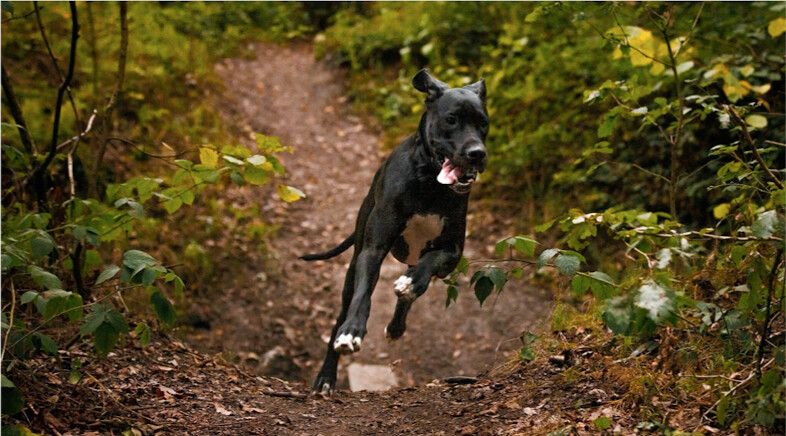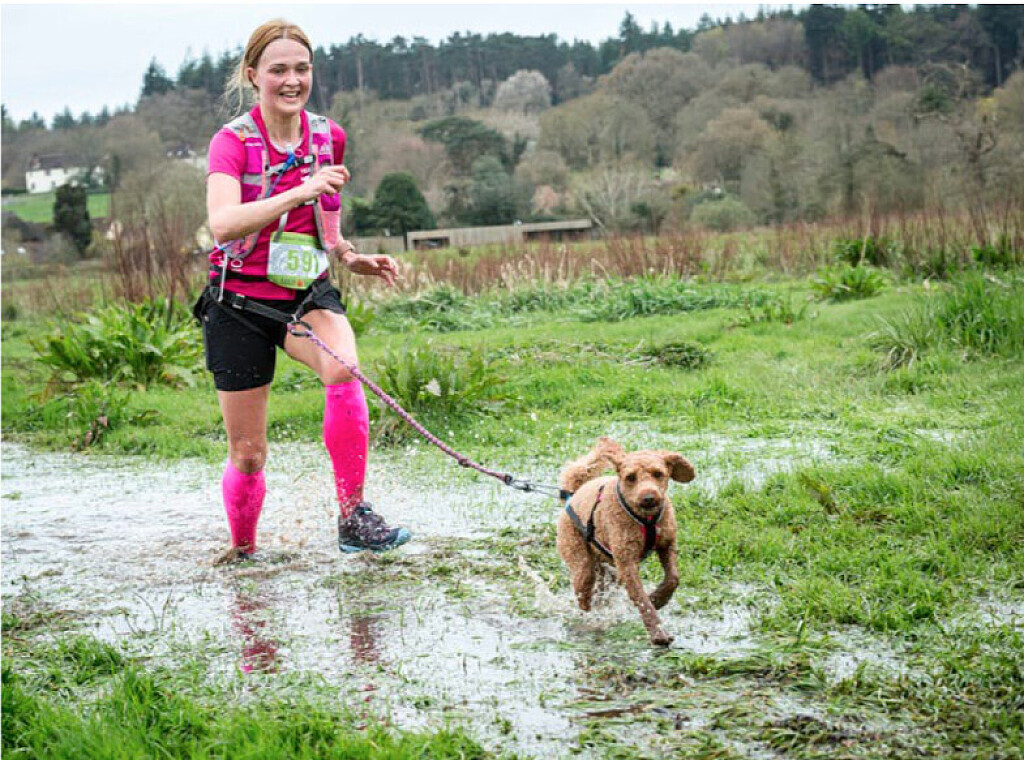Running News Daily
Running News Daily is edited by Bob Anderson. Send your news items to bob@mybestruns.com Advertising opportunities available. Train the Kenyan Way at KATA Kenya and Portugal owned and operated by Bob Anderson. Be sure to catch our movie A Long Run the movie KATA Running Camps and KATA Potato Farms - 31 now open in Kenya! https://kata.ke/
Index to Daily Posts · Sign Up For Updates · Run The World Feed
What to Do if Your Trail Dog is Obsessed With Wildlife
Prey drive is a natural—but frustrating—part of running with a canine companion. Expert trainers share their tips for improving on-trail obedience.Running with your dog can sure sound dreamy. In theory, your faithful companion motivates you to hit the trail each morning, burns off his extra energy, and then snoozes peacefully while you clock in at work. Positively idyllic—right?
The bad news is that reality can sharply differ. If your dog loves a good chase, you might feel less like you have a training buddy and more like you have a beast on a leash—a wild-eyed running partner that lunges toward rabbits, birds, even deer as you fight to remain upright.

If this sounds familiar, you might have a dog with a high prey drive. While this fixation on wildlife is a frustrating experience—and not the easiest behavior to control—there’s still hope of a breezy running partnership. Here’s what you need to know.
Prey drive describes how motivated dogs are to perform predatory behaviors. Most dogs have some inclination to predate (they’re descended from wolves, after all). But, compounding the issue, domesticated dogs sometimes show predatory behaviors that are even more exaggerated, says Tracey McLennan, a dog trainer specializing in prey drive. “For many dogs, it’s been deliberately bred into them.”
The late biologist Raymond Coppinger described predatory behaviors as happening in a certain order, which he called the “predatory motor sequence.” The sequence is as follows: Orient, eye, stalk, chase, grab-bite, kill-bite, dissect, and consume (though some scholars have proposed variations on this). Some breeds—especially those popular among runners—are predisposed to favor certain steps of this sequence. Picture a border collie working sheep: Their characteristic creeping and darting around the flock consists of amplified eye, stalk, and chase behaviors. Pointers, meanwhile, will prefer to orient toward and stare at prey (even as young puppies), just as they were bred to do to aid hunters. Many terriers, however, do it all— unsurprising, since they were bred to track down, chase, and kill rodents.
In other words, your wildlife-obsessed dog isn’t maliciously disobedient or unintelligent; it’s probably just doing what it has been bred to do.
It may seem counterintuitive, but giving your dog an opportunity to (safety) practice predatory behaviors can ultimately help you get them under control. Completely suppressing predation can leave dogs with pent-up frustration, says McLennan, making them more likely to jump after that rabbit and rip the leash from your hand. “I think that a lot of people are going around with dogs with [prey] desires through the roof because they never have an outlet.”
To find an outlet, think about what your dog likes to do. Most dogs are hunting well before they actually give chase, says McLennan. Some enjoy sniffing around for birds or squirrels, others like to scan for and stalk prey, and some do indeed live for the chase. Watch your dog’s body language on walks, or note their favorite ways to play with toys. Consider their breed type and what purpose they’ve been selectively bred for.
Most dogs love scent training, which engages their drive to search for prey and use their nose (which is at least ten thousand times as powerful as ours). This can be as simple as hiding your pet’s treats or toys for them to sniff out, or tossing their kibble into grass or a snuffle mat. Looking for a shared hobby? Try a scentwork class offered at a local training center or online.
Dogs that like to chase will likely go crazy for toys like the flirt pole—essentially a giant cat toy. And dogs that love to grab and bite prey tend to thrive on playing tug. Some canines also enjoy dissecting prey, so providing opportunities to chew and shred can help meet that need; this can include letting them tear apart toys or cardboard, or lettuce leaves if they are prone to swallowing the pieces.Better gear can instantly improve dog jogs. If she was running with a prey-driven dog, “I would 100-percent get a canicross harness,” says McLennan. In canicross, the dog wears a harness connected to their handler’s waist harness (not unlike a climbing harness), allowing the dog to forge ahead and give their owner a boost.
That said, before stepping into a canicross harness, it helps to train some skills. McLennan recommends teaching your pup one cue to stop running, and another cue to jog by your side. As much as a strong dog can boost your confidence when running uphill, they can also send you flying when you’re descending technical steeps.
If you’re not ready to put on a harness yourself, a waist leash with a bungee can reduce the impact of sudden pulls and save your wrists by allowing you to run hands-free.
Teaching—or refreshing—core obedience commands is also a critical foundation for harmonious runs. A pet well-versed in “heel,” “come,” and “stay” will be more manageable in all situations, including around wild animals, says Rachel Laurie Harris, a dog trainer who often hikes with her two American Staffordshire terriers in Colorado.
Mastering those skills may seem impossible when your dog can only think about rabbits. But breaking each skill down into small steps and getting in a lot of successful reps can improve your dog’s responsiveness. “As a general rule, if people can spend time bonding with their dog and working on training at home, it’s very likely that that’s going to yield more success with some of the prey drive on the trail,” says Harris.
For example, teaching dogs to come when called works best when you start in a distraction-free setting like your house, and reward heavily when your pup runs toward you. Then work up to practicing the same skill in busier places—like your local park—using a backup like a long line to prevent your dog from blowing you off.
If your dog is usually attentive and obedient in less-distracting and critter-free environments, it may be time to step it up to the next level: practice around prey. First, identify what animals your dog is most interested in, says Harris. For example, her dog Waylon is particularly tempted by larger animals like deer, moose, and mountain goats. (He doesn’t care much for chipmunks.)
Then, find an area where it’s likely you’ll encounter that kind of animal. Begin by training at a distance where your dog can see the prey but will still listen to you. No matter how well your dog has been doing at home, be sure to use a leash or a long line during this phase of training. “The hard truth is that if your dog gets opportunities to chase wildlife, that is always going to be much more relevant and reinforcing to them than anything we can do,” says Harris. “Prevention is key.”
Harris also recommends carrying rewards for your dog. If they love treats or toys, keep those handy to reinforce good manners around wildlife. You can even use their instincts as the ultimate reward—for example, letting them go sniff a bush a rabbit leaped into after they respond to “come” or “sit.” It’s just like grandma’s rule: If you eat your vegetables, you can have a little dessert.
Above all, be patient with your pup, trainers say. Predation is a hard-wired behavior and it’s not easy to convince your dog to choose you over the bird, rabbit, or deer. “We have to remember that good behavior change just takes time,” says Harris.
by Outside Online
Login to leave a comment




